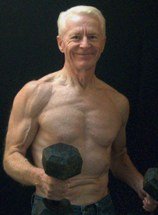| Back to Back Issues Page |
 |
|
The Gray Iron Fitness Newsletter, Issue #212. Are bodybuilders weird? Some people think so. October 01, 2017 |
Hi
October 1, 2017
In this newsletter . . . Are Bodybuilders Weird?When regular people hear the word bodybuilding, many of them, maybe most, think of the almost freakish looking men and women on the covers of some muscle magazines. It wasn’t always that way. The magazine covers in years past featured, say, Steve Reeves, or a John Grimek. They were images even people outside the workout world could admire. Strongman and author Brooks Kubik writes about the lifters and bodybuilders of the early and mid-20th century and their training. These were real athletes who may have flexed muscles on stage, but they were not just posers. A man like Grimek was Mr. America (twice), but also a national champion of Olympic style lifting.
Still, athletic and powerful though they were, they were in fact bodybuilders. It is too bad the term got tainted. Jack LaLanne, a bodybuilder who was certainly athletic by anybody’s measure, said that anyone simply doing some push-ups for fitness was, in fact, bodybuilding. Who can argue with that? Steroid use played a huge role in corrupting the word. And unfortunately, the average person may not recognize the distinction between bodybuilding's steroid users and nonusers. Personal note At my age, I no longer resemble a bodybuilder or athlete. For an old guy, I’m in decent shape. But I purposely carry a lot less bulk than I did when I was younger, about 30 pounds less in fact. I believe it is healthier at my stage in life. If asked what I do for exercise, I usually say resistance training with some cardio mixed in. I purposely stay clear of the B word. Perfectly good words get high jacked. Behold the Cloth Tape Measure Of all the tools used for analyzing health and fitness, a simple cloth tape measure may be one of the best. Measuring the circumference of your waist will tell you more about your fitness than either scales or the Body Mass Index (BMI) formula. Jack LaLanne was fond of saying, “Your waistline is your lifeline.” Jack was ahead of his time. Trainer and author Jon Benson (Fit Over 40) takes the tape measure method a step further, using a waistline-to-height formula as a predictor of heart disease. Mr. Benson tells us to measure right below the navel, and do not pull the tape measure tight. Write down that number in inches. Then measure your height (without shoes) in inches. Write that down too. Multiply your waist measurement by two. If the number is greater than your height, you are four times more likely to get heart disease. It’s more predictive than cholesterol tests, he says. The medical profession seems to agree. Everyone has a fitness story
Why not share yours with our readers on the Senior Exercise Central web site? Here are few subjects and ideas that I know other readers like knowing about . . .
If you like the newsletter, we're making it easy to share it . . .  Newsletter Policy The Gray Iron Fitness Newsletter is a free publication sent twice monthly to subscribers. The purpose is to provide honest and realistic fitness information for people age 50 and above. I have never been paid or received compensation of any kind to write a positive review or endorse a product. If I say that I personally use a product or service, it is because I find value in it and have paid for it with my own money. Like newspapers, magazines and television, this newsletter and my web site contain advertising and marketing links. Naturally, I am compensated for these. The newsletter and web site provide information to help users establish and maintain a fitness lifestyle. But fitness information is not the same as fitness advice, which is the application of exercise and dietary practices to an individual's specific circumstances. Therefore, always consult with your physician for assurance that fitness information, and your interpretation of it, is appropriate for you. Your comments and questions are always appreciated. Simply click on the "Reply" bottom. |
| Back to Back Issues Page |